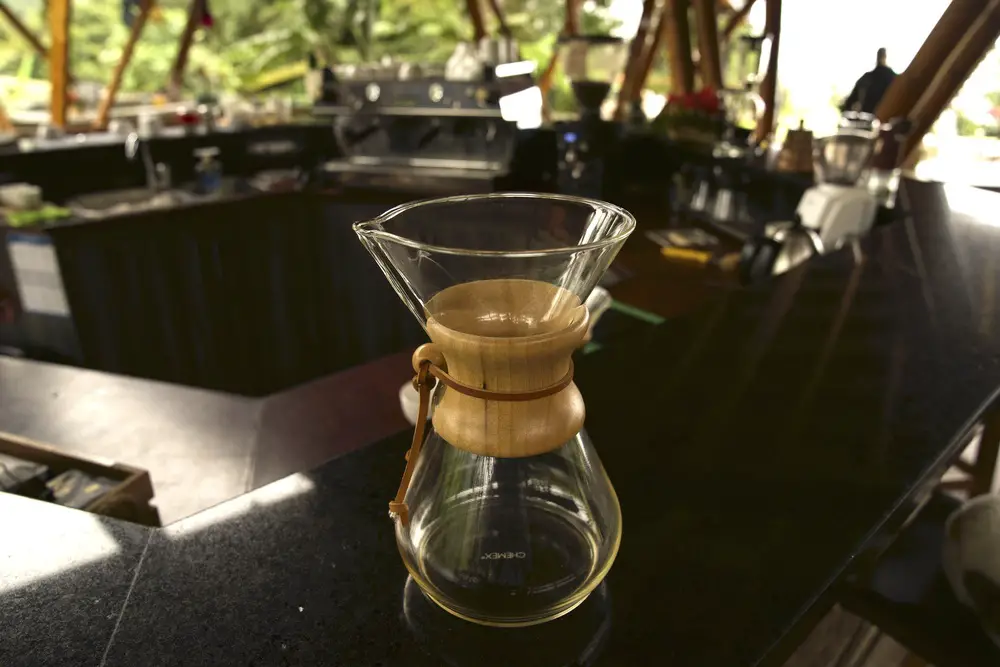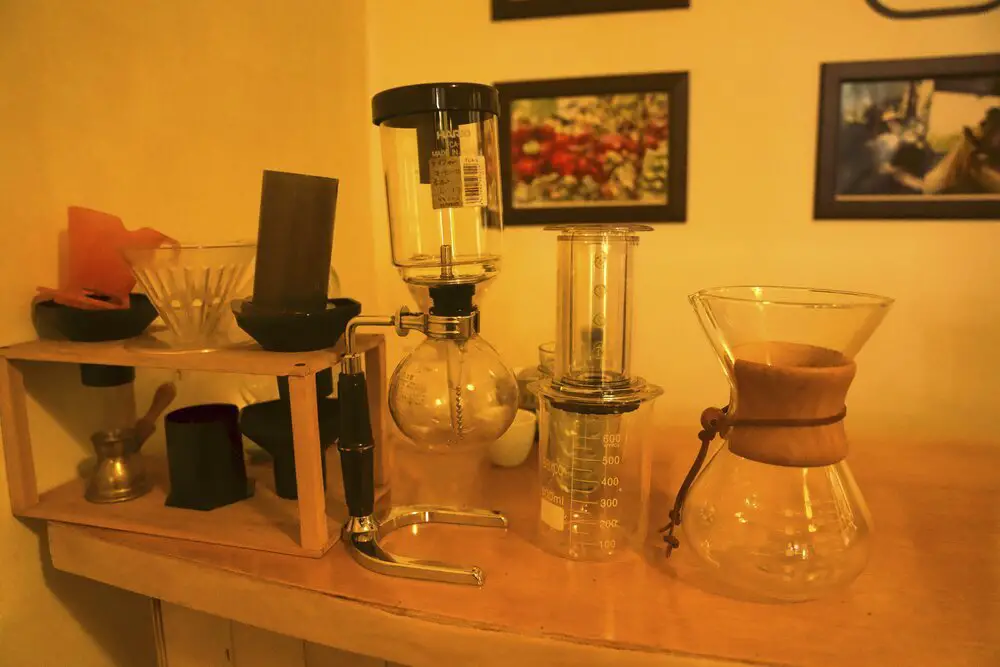The Chemex is unique among coffee machines. While many of today’s devices are rather modern, the Chemex is actually an 80-year-old invention.
The German chemist Dr. Peter Schlumbohm developed the Chemex coffee maker in 1941. Over the course of his career, he created more than 300 patents, ranging from automobiles to cocktail shakers. His goal was to improve the usability, attractiveness and aesthetics of common products.
Table of Contents
The Chemex coffee machine
The Chemex is a coffee machine with a timelessly elegant design and a very popular functionality. The hourglass shape and sturdy wooden handle are instantly recognizable. The relatively simple brewing process makes the Chemex a powerhouse in the world of specialty coffee.
The Chemex brews the coffee using the infusion process, making it more similar to drip coffee in terms of body and flavor. The Chemex filters are 20-30% thicker than filters using other methods such as the Hario.
The result is a slower brewing time and a richer cup of coffee. The Chemex produces a cup of coffee without deposits.
There are 4 Chemex models: 3 cup, 6 cup, 8 cup and 10 cup.
History of the Chemex coffee machine
Melitta registered her invention with the patent office in 1908, and by 1941 this method with the Melitta filter was already being used in almost every German household and nobody had a machine. You put the V-shaped porcelain filter with the accompanying paper on a pot, added the ground coffee and brewed it with boiling water. For that time, the Chemex was a very innovative coffee machine, even if it only became the focus of world public opinion much later.
Schlumbohm had two goals in mind when designing the Chemex: to simplify the preparation of the ideal cup of coffee and to create a work of art. As a chemist, he researched and understood the science of extracting flavor and caffeine from the coffee bean. He also applied this knowledge to filters that are perfectly matched to the Chemex to ensure maximum extraction.
The Path to Chemex Consolidation
In 1942, a year after Schlumbohm first patented the Chemex, he provided a model to the buyer at Macy’s, who began advertising the coffee maker. The first advertisements touted the Chemex as “brewing coffee the chemist’s way” and the first 500 models were produced that same year.
Schlumbohm presented the Chemex to the Museum of Modern Art as part of the Useful Objects exhibit. By 1949, the Chemex Corporation, which began in half an apartment, had expanded to three floors of the building.
From 1952, Dr. Schlumbohm on how he marketed and presented his products to the world. He disliked the somewhat misleading tactics advertisers used to woo consumers.
Schlumbohm preferred to write his own publicity, advertisements, and informational materials about his inventions. He wanted to educate people about the perfect filtration of the Chemex system and let the product speak for itself. He gave away Chemex coffee makers to celebrities and personalities hoping to garner their public support. Over the years, he amassed an incredible mailing list of potential users.
In 1958, the Chemex was considered one of the best designed products of modern times by designers at the Illinois Institute of Technology and was included in the permanent collection of the Museum of Modern Art in New York.
Chemex Expansion
Dr Schlumbohm also had a desire to provide the perfect coffee in coffee shops and restaurants.
By 1961 he invented and produced the Chemex Samovar, considered the original “batch brew” and capable of brewing up to 36 cups of coffee. He only supplied the device to restaurants if they signed a license agreement in which they undertook to comply with certain parameters, e.g. B. To follow the instructions carefully and not to exceed the 36-cup limit.
1962 died dr. Schlumbohm and the company was handed over to Vice President Marie Foley. She had been with Chemex from the start and even helped assemble the first 500 Chemex coffee machines. She stayed with the company for a few more years before selling it to a private owner.
During the 1960s and 1970s, the company continued to grow as it introduced innovations to the coffee maker. For example, the wooden collar was replaced by a plastic collar or a handle. These materials are cheap, strong, and comfortable, but not as pretty to look at as a beautiful glass design.
In 1980, Chemex Corporation officially became a family business when Patrick and Liz Grassy took over the business. Patrick took over the role of President and his wife Liz took over the marketing department.
The popularity of Chemex in the new millennium
Chemex’s popularity skyrocketed in the new millennium. People wanted more ways to make great coffee at home, which led to an influx of new and different coffee makers, including home espresso machines. But given the high prices, options like the Chemex became more and more attractive.
In 2013 Chemex decided it was time to refresh the brand. Again, a new color palette is designed, the logo is updated and two new products are introduced: a cup modeled after the Chemex and a container for sugar or cream. A year later they launch a revised automatic version of the Chemex.
In 2019 it even had its own video game called “Brew Perfect”. It is designed not only to entertain but also to educate and help you to brew the perfect cup of coffee with the Chemex.
layout
The Chemex has a beautiful design. That’s because Chemex has stayed true to its original design, using glass, wood and leather.
Schlumbohm was inspired by non-porous laboratory equipment that has no taste of its own and by the Bauhaus design school.
Specifically, there were two scientific elements that inspired him to create this coffee machine: his glass laboratory funnel and his Erlenmeyer flask. He built an air duct in the funnel so that the air displaced by the incoming liquid could escape unhindered. He modified the Erlenmeyer flask by adding a “navel” and combined it with the modified glass funnel. Along with the charming wooden handle, he received a one-piece, heat-resistant, borosilicate glass coffee pot.
Due to its distinctive mid-century design, the Chemex coffee pot has had a strong presence in pop culture. In Ian Fleming’s film “From Russia, With Love” James Bond prepares his coffee with a Chemex. Glass coffee pots are in Don Draper’s kitchen in Mad Men and in Woodhouse’s kitchen in Rosemary’s Baby.
Conclusion
Chemex is one of the most popular coffee machines in the world. The Hario V60 is the only real competitor to use a similar brewing method and get similar results.



